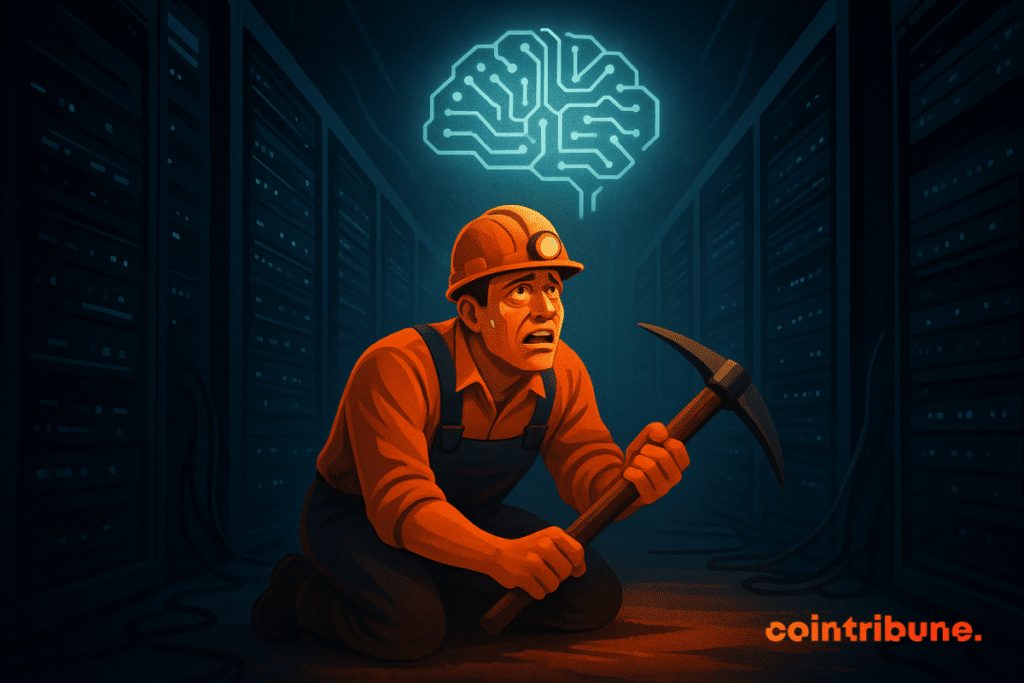Bitcoin Miners Take on Record Debt as AI and HPC Fuel a New Era of Digital Infrastructure
Bitcoin miners are taking on record levels of debt to finance new equipment and expand operations into artificial intelligence (AI) and high-performance computing (HPC). As competition for hashrate intensifies and post-halving profits shrink, miners are increasingly turning to debt markets to maintain an edge in both Bitcoin production and data infrastructure growth.

In brief
- Bitcoin miners’ total debt skyrockets from $2.1B to $12.7B—a 500% surge driven by new tech and efficiency upgrades.
- The 2024 halving cut rewards, pushing miners toward AI and HPC hosting for stable, long-term income streams.
- Companies like Bitfarms and TeraWulf raise billions through debt to build AI-ready data centers in North America.
- VanEck says the AI shift enhances Bitcoin’s energy efficiency while supporting stronger network security.
Hasrate Pressure Drives Bitcoin Miners to Record Borrowing Levels
A recent report from investment firm VanEck shows that total debt among Bitcoin miners has soared from $2.1 billion to $12.7 billion in just 12 months—a nearly 500% increase. Analysts Nathan Frankovitz and Matthew Sigel noted in VanEck’s October Bitcoin ChainCheck report that miners face mounting pressure to upgrade hardware and boost efficiency or risk losing their share of the global hashrate.
VanEck’s analysts warned that miners who fail to upgrade their hardware risk losing ground in the global hashrate race, directly cutting into their Bitcoin earnings. They call this the “melting ice cube problem,” where older machines rapidly become less efficient and unprofitable.

Historically, mining companies relied on equity rather than debt to finance major capital expenditures. But VanEck noted that Bitcoin’s price volatility has made equity financing increasingly costly. In contrast, debt markets now offer miners greater flexibility as they diversify their income streams.
Data shows that mining companies have taken on a significant amount of debt over the past year:
- The Miner Mag reported that public Bitcoin miners issued a combined $4.6 billion in debt and convertible-note offerings during Q4 2024.
- At the start of 2025, total financing activity plummeted to just $200 million, reflecting a sharp market cooldown following the 2024 halving.
- By Q2, borrowing activity rebounded to $1.5 billion as miners pushed to fund AI and HPC infrastructure growth.
This rising reliance on borrowing highlights miners’ adaptation to shifting market conditions.
Miners Diversify into AI and HPC Hosting
After the April 2024 Bitcoin halving, which cut block rewards to 3.125 BTC, profitability across the mining sector fell sharply. In response, many operators began repurposing part of their energy capacity for AI and HPC services.
Hosting compute-intensive workloads allows them to generate steadier, more predictable cash flows through long-term contracts.
Frankovitz and Sigel observed that miners expanding into AI and HPC services are generating steadier cash flows through multi-year contracts, reducing their reliance on Bitcoin’s volatile price cycles.
The relative predictability of these cash flows has enabled miners to tap into debt markets, diversifying their revenues from Bitcoin’s speculative and cyclical prices and lowering their overall cost of capital.
Frankovitz and Sigel
Several major mining firms have launched large-scale financing initiatives tied to AI and HPC infrastructure. Bitfarms closed a $588 million convertible note offering in October to fund new data center projects across North America.
Meanwhile, TeraWulf announced a $3.2 billion senior secured notes offering to expand its Lake Mariner campus in Barker, New York. IREN also completed a $1 billion convertible notes deal, allocating part of the funds for general corporate purposes and working capital.
AI Shift Strengthens Bitcoin’s Energy Ecosystem
Although the growing focus on AI infrastructure might seem to be a shift away from traditional Bitcoin mining, VanEck analysts argue that the trend ultimately strengthens the broader ecosystem. Miners play a crucial role in validating Bitcoin transactions, and rising hashrates continue to bolster network security.
They added that AI demand fluctuates throughout the day with user activity, enabling miners to optimize energy use between AI workloads and Bitcoin mining.
The report also revealed that several miners are exploring new ways to use their power capacity when AI demand drops. Some are testing systems that repurpose excess energy during low-demand periods, reducing or eliminating the need for costly backup power sources such as diesel generators.
Even though the idea is still in its early stages, it could mark the next step in linking Bitcoin and AI. More so, this move could improve how miners manage both financial and energy resources.
As the hashrate race accelerates and AI adoption expands, miners are entering a new phase—one defined by high leverage, rapid reinvention, and a growing convergence between digital assets and data infrastructure.
Maximize your Cointribune experience with our "Read to Earn" program! For every article you read, earn points and access exclusive rewards. Sign up now and start earning benefits.

James Godstime is a crypto journalist and market analyst with over three years of experience in crypto, Web3, and finance. He simplifies complex and technical ideas to engage readers. Outside of work, he enjoys football and tennis, which he follows passionately.
The views, thoughts, and opinions expressed in this article belong solely to the author, and should not be taken as investment advice. Do your own research before taking any investment decisions.